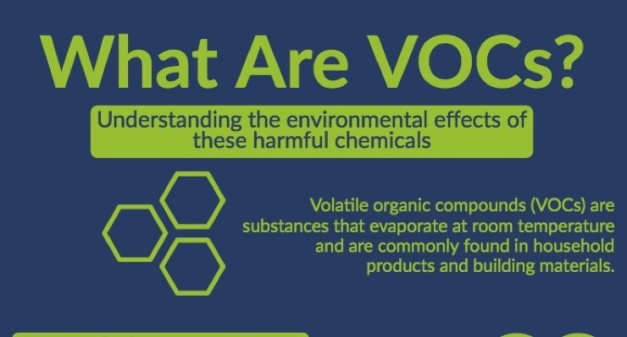Description

Copyright infringement not intended
Context:
- India can slash emissions of volatile organic molecules (VOC) by 76 per cent in the next eight years by swapping all vehicles with electric vehicles and all diesel-fuelled ones with Compressed Natural Gas (CNG) – Study.
About:
- Volatile organic compounds (VOC) are organic chemicals that have a high vapour pressure at room temperature.
- VOCs are found in a wide variety of products such as solvent-based paints, printing inks, many consumer products, organic solvents and petroleum products. Motor vehicles and vessels also emit VOCs that eventually cause air pollution and smog.
- Volatile organic compounds (VOCs) are emitted as gases from certain solids or liquids. VOCs include a variety of chemicals, some of which may have short- and long-term adverse health effects.
- High vapor pressure correlates with a low boiling point, which relates to the number of the sample's molecules in the surrounding air, a trait known as
- VOCs are responsible for the odor of scents and perfumes as well as pollutants.
Role:
- VOCs play an important role in communication between animals and plants, e.g. attractants for pollinators, protection from predation, and even inter-plant interactions.
- Some VOCs are dangerous to human health or cause harm to the environment.
Sources of VOCs:
Household products, including
- paints, paint strippers and other solvents
- wood preservatives
- aerosol sprays
- cleansers and disinfectants
- moth repellents and air fresheners
- stored fuels and automotive products
- hobby supplies
- dry-cleaned clothing
- pesticide
Other products, including:
- building materials and furnishings
- office equipment such as copiers and printers, correction fluids and carbonless copy paper
- graphics and craft materials including glues and adhesives, permanent markers and photographic solutions.
Impact of VOCs on Health:
- When VOCs are released, they react with nitrogen oxides in the air and form ground-level ozone. Ground-level ozone can irritate the eyes, nose, and throat. It can also aggravate asthma and other types of lung diseases.
- Exposure to VOCs themselves can also cause both short-term and long-term health effects. These effects include:
- Irritation to the eyes, nose, and throat;
- Damage to the liver, kidneys, and central nervous system;
- Nausea;
- Headaches and dizziness;
- Loss of coordination
- VOCs can also potentially cause visual impairment and memory loss. Some VOCs such as benzene and formaldehyde are proven carcinogens.
Impact on Environment:
- When VOCs react with nitrogen oxides and create ozone molecules, they also create fine particulates.
- Ground-level ozone and fine particulates are both key pollutants in the creation of smog.
- Ground-level ozone can also harm plants by reducing their growth and leaving them vulnerable to pests and disease.
- VOCs are also a contributor to acid rain. Acid rain can kill aquatic wildlife and wash away important nutrients from the soil. Acid rain also releases aluminum, which can harm animals and trees.
How do VOCs cause smog?
- VOCs play a significant role in the formation of ozone and fine particulates in the atmosphere.
- Under sunlight, VOCs react with nitrogen oxides emitted mainly from vehicles, power plants and industrial activities to form ozone, which in turn helps the formation of fine particulates.
- The accumulation of ozone, fine particulates and other gaseous pollutants results in smog that reduces visibility.
- Smog can irritate our eyes, nose and throat, or can worsen existing heart and respiratory problems such as asthma.
|
Non-methane volatile organic compounds (NMVOC) are VOCs minus methane, a greenhouse gas.
|
Suggestions to tackle VOCs:
- Multi-tier regulation with different regulatory bodies applying different thresholds for VOC limits in the products.
- Applicability of regulations on all strata – Manufacturers, Distributors, and Retailers.
- Adopting e-mobility
Technologies for emission control of VOC in industrial settings:
- Reduction in Volatility from the crude oil.
- Thermal Oxidation: VOC laden air is combusted using enclosed flares to catalytic oxidisers with heat recovery.
- Absorption: Dissolving hydrocarbons in the absorbent and removing it from the air/vapour mixture.
- Membrane Separation: This technique uses a liquid compressor and a semi-permeable membrane to separate organic molecules from air/vapour mixtures.
- Cryogenic Condensation: It involves passing the vented gas/vapour through a nitrogen-cooled condenser and this method can reach over 99% efficiency.
https://www.downtoearth.org.in/news/pollution/electric-vehicles-can-lower-emissions-of-volatile-organic-compounds-in-india-by-2030-study-81488#:~:text=Published%3A%20Thursday%2010%20February%202022&text=India%20can%20slash%20emissions%20of,a%20new%20study%20has%20predicted.










